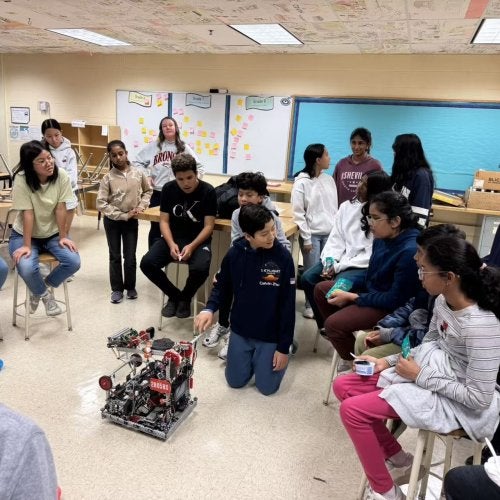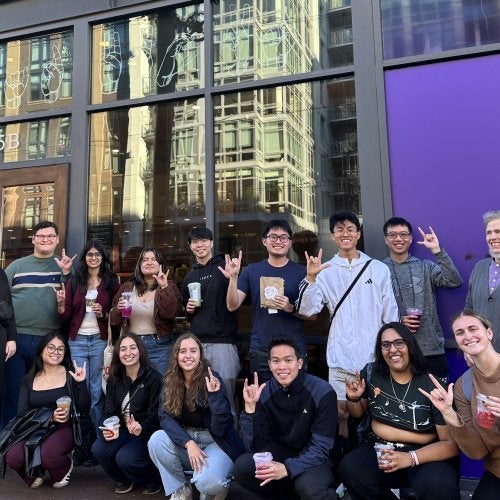
Mentoring programs that pair early career teachers with experienced educators are a common practice in PK-12 schools across the nation. Often implemented for the purpose of providing support to early career educators as they transition into the classroom, these formalized pairings are widely considered to be one of the most effective strategies for supporting early career teacher success and retention (Caven, 2021). The proliferation of mentorship programs for early career teachers speaks to a simple truth: mentorship matters. Dean Kimberly Griffin at the University of Maryland College of Education, suggests that school leaders build on the success of mentorship programs by fostering a culture of mentorship in their schools.
Griffin describes a culture of mentorship as a “shared commitment” within a school community to each person’s personal and professional development. In addition to matched mentors and mentees, there is an informal approach to mentorship, where everyone within the community has the capacity to offer guidance at any time. According to Griffin, communities with a strong culture of mentorship are associated with achievement, increased learning and growth and greater job satisfaction. Griffin suggests the following five high-impact strategies for promoting a culture of mentorship in your school this year.
1. Encourage a network of mentors rather than just 1:1 relationships
Building a culture of mentorship begins with encouraging mentoring networks, rather than relying on 1:1 mentoring relationships alone. Mentoring networks include multiple people that can offer a new teacher different kinds of support. This allows mentees to connect with different mentors based on their specific needs. Sometimes there is a mismatch between mentee needs and an assigned mentor’s expertise and a network of mentors can address this issue. Another benefit is the formation of unlikely mentoring relationships. Griffin explains: “Let's say I'm an English teacher and I need a mentor. I may think, surely, they should be a more senior English teacher, they should teach at my school and it would be great if our identities matched. I might overlook a math teacher that could be really helpful in thinking through how I lesson plan or engage in classroom management.” A formal dyad puts pressure on one mentor to be responsible for the growth of the mentee when in reality it takes a village to properly support new teachers.
Mentoring networks don't only benefit mentees; these networks also help individuals who may not see themselves as mentors try on that role. Those who do not have formal mentoring experience might be hesitant to take on the role but Griffin notes that experience is not a requirement. “Everybody has something or some part of their job that comes to them easily or that brings them a lot of joy. Encouraging them to share that is valuable, particularly for new colleagues. That information can be really helpful and support the next generation of educators who are coming up in the field.”
2. Foster mentors of the moment
Griffin reminds us that the magic of mentoring is often in small moments and suggests leaders foster opportunities for faculty and staff to be a mentor of the moment for each other. Informal mentorship can happen organically during a coffee break, at lunch, or even at the water fountain. For leaders, it’s all about creating opportunities for these micro interactions and moments of mentoring to occur, particularly among colleagues who may not otherwise cross paths.
In team meetings, this might sound like asking if anyone has a challenge they want to share and creating the space for colleagues to workshop problems of practice together. This type of mentorship may seem small and be short term, but is advantageous to the development of a culture of mentorship and supportive community.
She advises mentees to foster interactions on their own as well: “We have this kind of general ethos in our country around pulling yourself up by your own bootstraps. It might feel like, ‘Why do I need this special thing? I should be able to do this on my own’, which might keep someone from asking for a mentor.” However, Griffin notes, the benefits of mentorship greatly outweigh the risk of vulnerability. For mentees seeking support, Griffin suggests trusting your gut, “Be alert and mindful of those people that you might feel a unique connection with” and start developing those bonds.

3. Develop care as a competency
Care and mentoring are not exclusive practices. Effective mentoring involves more than skills-based coaching; it relies on a combination of logic and feeling. “Mentorship is heart work and there's an important emotional component,” says Griffin. This involves seeing mentees as whole people, talking about their hard emotions and supporting their mental wellbeing.
Identifying care as a competency of effective mentors involves acknowledging that creating space for the emotional and mental well-being of our colleagues and exercising empathy for their experiences are not only essential to effective mentorship, but are learnable skills. Asking about the personal lives of mentees, learning their career goals and ambitions are a few ways to exemplify care. “Be mindful of asking people how they are, especially when they have challenges that they're navigating or when they experience failure,” says Griffin. “Showing up to listen, offering affirmations and helping that person build confidence are important competencies.”
4. Consider mentees’ identities
Leaders seeking to foster a culture of mentorship within their schools should be mindful that identity has the power to both reinforce and disrupt the impact of structural inequities on an individual's professional journey. Griffin explains, “There are certain experiences that people of color, women, members of the LGBTQ+ community, and people with disabilities, or marginalized identities more generally, are more likely to face”. For these individuals mentorship can be both critically important for their successful development and growth, and more challenging to access. Leaders should be intentional about creating spaces for individuals with marginalized identities to develop mentoring relationships and expand their professional networks, being mindful of the need to connect with colleagues from different and similar backgrounds. “Considering identity in mentoring relationships is really important,” Griffin says, “Especially if one of the goals of mentorship is to build equity in education.”

5. Reward mentoring in real and meaningful ways
Leaders seeking to foster a culture of mentorship should consider both intrinsic and extrinsic motivations to encourage people to mentor. Intrinsically, many people engage in mentoring relationships because of genuine care for the well-being and development of others. “They want to see others go on and do wonderful things,” says Griffin. However, mentorship is also real work that can feel burdensome, especially when it is not recognized or rewarded. Leaders committed to fostering a culture of mentorship within their communities may consider rewards to incentivize more active participation and investment mentorship. Institutional awards and recognition remind everyone that mentorship is valued by and important. When organizations recognize mentorship as legitimate work, not just an additional task on top of regular duties, it motivates others to participate,” explains Griffin. Stipends, release time, yearly review accolades and consideration for administrative or tenured positions are all ways that mentoring can be recognized and held up as important to supporting educators.
Building a culture of mentoring supports teacher retention and equips them with a realistic view of their careers. Ready to get started? Download this learning aid to ensure success with mentoring in your school.
We want to hear from you! Do you have a question that you would like Office Hours to answer? Submit questions here.



